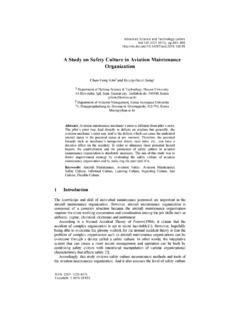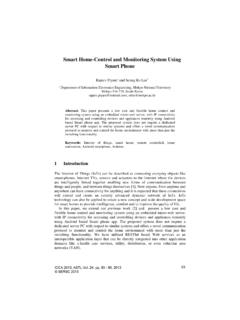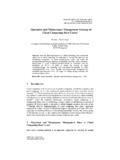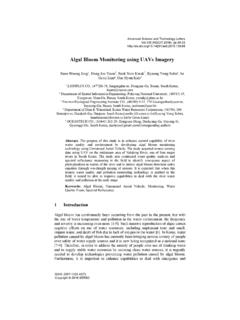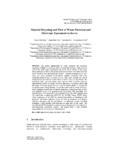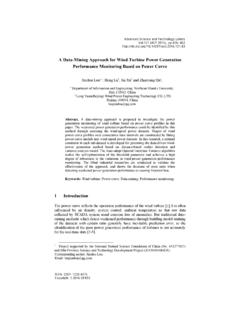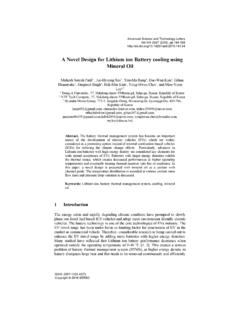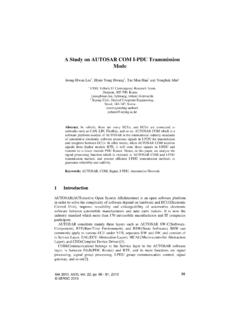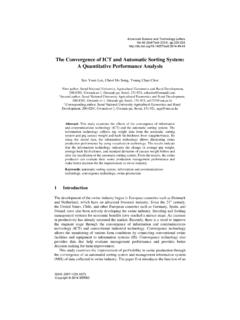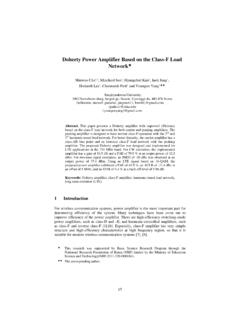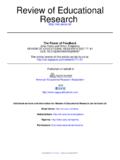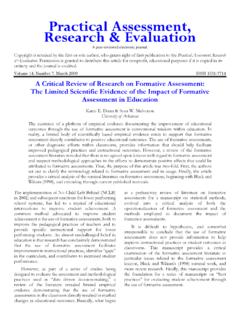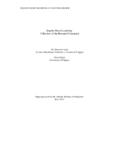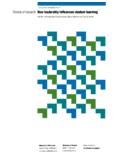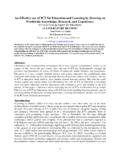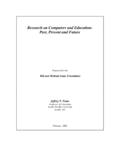Transcription of A Review of Exploratory Factor Analysis (EFA) …
1 Advanced Science and Technology Letters ( education 2014), A Review of Exploratory Factor Analysis (EFA). practices in english education research in Korea Sunhee Choi1,1, So Young Jang2. 1. Department of english Edeucation, Jeonju University 303 Choenjam-ro, Wansan-gu, Jeonju 560-759 Jeonbuk, Korea 2. Institute of Educational Development, Kunsan National University 1170 Daehak-ro, Gunsan 573-701 Jeonbuk, Korea Abstract. The present study aims to Review and analyze Exploratory Factor Analysis (EFA) practices adopted in english education research in Korea. 41. articles published in six major journals over the last 10 years were reviewed with four evaluation criteria. The results show that EFA practices found in english education in Korea are not ideal likely due to the lack of understanding of theoretical assumptions and procedures of EFA.
2 The results are rather alarming given that unsound decision made along the EFA procedure can produce misleading results. Keywords: Exploratory Factor Analysis , english education , critical Review 1 Introduction Exploratory factory Analysis (EFA) is a widely used set of statistical procedure in educational research . EFA is useful to determine the number of latent variables or factors which can explain the pattern of correlations among a set of measures [1]. Although it looks like an easy-to-use statistical tool thanks to the development of powerful software programs, EFA requires a careful decision on every step of its procedure. As a matter of fact, the usefulness of EFA depends on how it is implemented [2], and it is highly likely that researchers' poor decisions can mislead study results and their readers [1], [3], [4].
3 Several reviews on the use of EFA have been published in other fields of research [2], [3], [5]. They revealed that researchers often times make poor decisions about the Factor extraction model, the criteria for deciding on the number of factors to retain, and the Factor rotation method. The goal of this study is to examine how EFA is applied in english education research practice. A total of 41 articles published in six english education journals during a ten-year period (2004-2013) were reviewed with a set of evaluation criteria. 1 The first and corresponding author ISSN: 2287-1233 ASTL. Copyright 2014 SERSC. Advanced Science and Technology Letters ( education 2014). 2 The Evaluation Criteria When conducting EFA, researchers are required to make several decisions on how the Analysis is conducted, whose results can influence the quality of their research [1].
4 The present study will mainly focus on the following four aspects of EFA decision making process which are believed to have critical impact on the outcome: (a). purposes for conducting EFA (b) Factor extraction model, (c) the number of factors retained, and (d) Factor rotating methods. Purposes for Conducting EFA. EFA can be conducted for several research purposes. First of all, it can be utilized when evaluating the dimensionality of a construct. In other words, the underlying structures of latent traits can be identified through EFA and the evidence can be used for evaluating construct validity. Often times, researchers move on to test their research hypotheses after the preliminary evaluation of the variables through EFA. Secondly, EFA can serve to validate new or existing scales when one attempts to develop or refine measuring instruments such as surveys or tests.
5 Factor Extraction Model Although there are a number of ways to extract factors , Principal Component Analysis (PCA) Model and the Common Factor Analysis (CFA) Model are most common. Yet, it is important to note that PCA and CFA were developed for different purposes using different mathematical models, and thus they could produce significantly different results in some cases even when applied to the same datasets [2], [6]. PCA was designed to summarize the data set by reducing them to a smaller set of uncorrelated principal components which are linear combinations of the original set of items. On the other hand, CFA is designed to discover unobservable latent constructs ( , common factors ) which are postulated to cause the measured variables [6]. Number-of- Factor Decision Criteria The important task at the beginning of the extraction process is to determine the number of initial factors that correspond to the dimensions of a target construct [6].
6 One of the most widely used selection procedures is to use the number of the eigenvalues of the correlation matrix which are greater than 1. Another popular method is the scree test. A scree plot maps extracted factors against their eigenvalues in descending order. Another common method is parallel Analysis which involves comparing eigenvalues from a reduced correlation matrix calculated with the actual scores on the measured variables with those from a random score reduced matrix produced [1]. It is often suggested that multiple criteria should be applied when determining the number of factors to retain in a model. 245. Copyright 2014 SERSC. Advanced Science and Technology Letters ( education 2014). Factor Rotating Methods After determining the number of factors , the factors are usually rotated in order to increase the interpretability of the Factor structure [3], [7].
7 There are two options for analytical rotation methods: the orthogonal rotations considering factors uncorrelated and the oblique rotation allowing correlated factors . Orthogonal rotations seem to be conceptually simpler since it does not allow Factor correlations. However, oblique rotation may provide more interpretable and better solution when the factors or variables are theoretically and in reality correlated. 3 Review Process Every article from six major english or second language education journals published in Korea from 2004 through 2013 was examined. A total of 41 articles were found to have included Factor Analysis either as the major statistical procedure or as rather a preliminary procedure for other purposes. Given the fact that more than 2000 articles were examined and EFA has been widely used in other education research areas, 41 is rather a small number.
8 The number of articles garnered from each journal is as follows: english Teaching (13), Modern english education (1), Foreign Language education (14), english Language & Literature Teaching (3), english Language Teaching (4), and Korean Journal of Applied Linguistics (6). 4 Results Table 1 shows that EFA is most frequently conducted to identify the underlying Factor structures of new or ad hoc scales (40%). Table 1. Purposes of conducting EFA. Purposes N %. To reduce the number of variables 2 5. Preliminary evaluation of an existing scale 10 23. To a scale before hypothesis a new or ad hoc scale 17 40. understand testing a modified scale 4 9. latent Development and a new or existing scale (EFA only) 6 14. constructs validation of an a hypothesized model before using 4 9. instrument CFA. Total 43 100. Table 2 illustrates the frequencies for the use of various types of Factor extraction models by Korean english education researchers.
9 The most popular model is Principal Component Analysis (CPA) which accounts for 41% of all the methods used in the field. This result is rather surprising given that CPA is best used when the purpose is to reduce a large set of variables to a smaller set, and the studies reviewed here used EFA more for testing construct validity of scales. Copyright 2014 SERSC. 246. Advanced Science and Technology Letters ( education 2014). Table 2. Factor Extraction Models Extraction Models N %. Common Factor Model Principal axis factoring 8 20. Maximum likelihood 2 5. Alpha factoring 0 0. Image factoring 0 0. Weighted least squares 0 0. Generalized least squares 0 0. Component Model Principal component Analysis 17 41. No Information 14 34. Total 41 100. As can be seen in Table 3, most studies adopted Kasier Criterion when deciding on the number of Factor , which is not too ideal.
10 It is recommended by several scholars that one should employ several criteria when determining the number of factors to be retained in the final solution. Table 3. Number of Factor Decision Criterion Criteria N %. Eigen values > 1 (Kasier Criterion) 28 58. Scree test 10 21. Parallel Analysis 0 0. The likelihood ration test statistics 0 0. Model fit 0 0. Factor interpretability 6 13. Percentage of variance accounted for 3 6. Theory 1 2. Total 48 100. Multiple methods* 10 out of 41 24. No information* 8 out of 41 20. Regarding the rotating method, varimax, an orthogonal rotation method, is dominant (46%) as shown in Table 4. Only 24% of studies used the oblique method which allows inter-correlation among factors . Yet, considering that a lot of variables or factors affecting english learning are correlated with one another, the result is not too positive.
